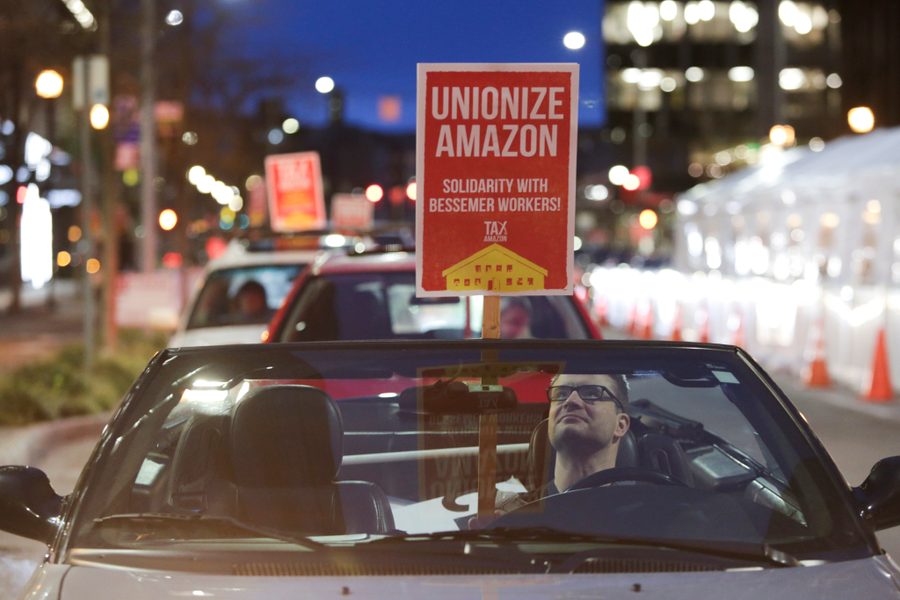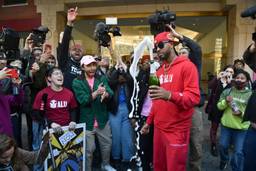“The Amazon Workers in Bessemer Would Already Have Their Union If We Had the PRO Act”
What the union loss at an Amazon warehouse in Alabama means for the future of organizing in the Biden era.
Kim Kelly and Shaun Richman

The April union election loss at an Amazon fulfillment center in Bessemer, Alabama has been treated in the media as a signal event for the labor movement in the Biden era. But what exactly it signaled remains subject to debate.
Kim Kelly is a freelance writer who covered the Amazon election on the ground for More Perfect Union. Shaun Richman, program director at SUNY’s labor center, previously directed the American Federation of Teachers’ charter school organizing division. Here they discuss changing worker attitudes, labor law, media coverage and organizing strategy as possible lessons to take from the loss in Bessemer.
Shaun Richman: Biden’s statement on the Amazon campaign in March, from a historical perspective, was the strongest pro-union message from any U.S. president. The Franklin D. Roosevelt quote that the CIO put on organizing posters, “If I went to work in a factory, the first thing I’d do would be to join a union,” almost has an unspoken, but I would never work in a factory contained within it. On Presidents’ Days, when unions’ social media people have to trot out these memes of presidential statements on unions, they’re pretty terrible. John F. Kennedy sounds like a negging pickup artist: “Our labor unions are not narrow, self-seeking groups. They have raised wages, shortened hours and provide supplemental benefits…” etc. It’s always stated as this negative they’re not all bad; some of them are actually fixing things. Whereas Biden strongly emphasized this being the workers’ decision and nobody gets to interfere with it — the federal government has your back. It was good and possibly a better signal to all workers organizing. How did that play out in a live organizing campaign in a warehouse in the deep South?
Kim Kelly: I think folks were impressed that the president was paying attention to what they were doing, and the idea that he was kind of urging them on, and clapping back at Amazon for all of the union busting techniques they’d been pulling out and hammering people with for months. But it came at a point where a lot of people had already voted. It would have been much more impactful if he’d come out in early February and said all that. It was a little Johnny-Come-Lately, I think, in terms of actual usefulness, but it helped.
SR: It might be a matter of timing. The original right to organize in the 1930s, Section 7a of the National Industrial Recovery Act just said you have the right to organize, but there was no enforcement mechanism, which is not dissimilar to our broken labor law system today. Even more impactful than FDR’s endorsement of joining a union were crusading senators like Robert La Follette Jr. and Robert Wagner holding hearings to interrogate employers who defied the law, and holding up stories from workers who were trying to form a union in the face of employer intransigence. And out of that came the drafting of the National Labor Relations Act, which was really meant to have some penalties for violating the workers right to organize, weak as it ultimately turns out that they were.
Biden’s statement was good, but now is Bernie going to pick up the ball and do the hearings? Is Warren? Because Amazon executives deserve to get grilled on the bathroom stall stuff and the mailbox. What are some of the worst things that you saw that Congress should be grilling them on?
KK: I’m generally skeptical about Congress doing anything, but hopefully the high-profile nature of the situation will mean that Bezos and his buddies will be held accountable in some way for what they pulled. Amazon has created its own surveillance state here; the workers clock in and do all their tasks through an app on their phone, so they were getting anti-union propaganda through the app and text messages, sometimes up to five a day, to their personal cell phones. Amazon bought billboards in the area. They set up a sketchy mailbox in front of the warehouse in defiance of the NLRB. They essentially bullied the county into adjusting the traffic light patterns at an intersection in front of the warehouse, where workers have been stopping to talk to organizers on their way in.
Some of this is legal, and it’s not unexpected that Amazon would try to innovate union busting and disrupt that space, but they can’t be allowed to keep doing this. If all of these politicians who made statements or tweeted about how they support these workers hauled Amazon’s corporate leadership up in front of them and grilled them on why they thought they could get away with it — at the very least it might be able to stop Amazon from using the same tricks or coming up with new ones. I’m not really sure what kind of power Congress has to force a private company to stop union-busting.
SR: In my experience, an elections appeal and unfair labor practice investigation process can really drag out and can pull more facts and private documents into the public sphere, and can create real leverage for a union to rerun the election on terms that are somewhat fairer. That depends on somebody in power also having some real leverage over the employer and saying, ‘Stop breaking the law or you’re not going to get this tax break or this government contract anymore.’ Or even, just: ‘Jeff Bezos, get ready to park your butt in this Senate hearing room.’
This seems like it’s changing for the better. When I was doing charter school organizing it was local politicians that we needed to weigh in. But because of “Democrats for Ed Reform” and a lot of rich education reformers who threw their money around, liberal Democrats who could have stopped the behavior of a specific charter school chain in their district that was firing union activists and blatantly violating the law, just wouldn’t touch it because of the political landscape. I think that’s changed.
The “organizing model,” which labor researcher Kate Bronfenbrenner developed through lots of scientific research in the 1980s — measuring the most effective union tactics and the most effective boss tactics, and measuring win rates as these tactics went head-to-head in surveys of NLRB elections — was also developed in a social context that contemporary activists tend not to appreciate. In the 1980s the experience was that politicians and the general public won’t really have much sympathy for a union or really care that the boss broke the law, and so we have to do most of our organizing in secret until we have a supermajority of workers ready to make a public demonstration of support for the union and, generally, a union organizing campaign has to be better than good to have a chance at winning.
This idea that nobody’s going to be sympathetic is out the window. You’ve got a bunch of members of Congress who intellectually understand that the decline of the labor movement causes Democratic election losses. But they don’t understand how deep the problems are. As much as it frustrates me that there are still a lot of unions that don’t follow science, the devotion to the organizing model has led the labor movement to sort of suffer in silence, because even the things bosses are allowed to do often fly under the radar, like captive audience meetings are outrageous when you actually explain to people what goes on in them.
What went on in Amazon’s captive audience meetings?
KK: One of the things that made the workers I spoke with so angry about it is that normally this is a company where if you show up one minute late, you’ll get docked an hour of your flexibility time. They only have 15 minutes for a bathroom break, 30 minutes for lunch. But Amazon has all the time in the world to sit them down in a classroom with an anti-union consultant who is being paid $3,200 per day, just droning at them for hours about how a union is going to take all your money, and the company might have to shut down the warehouse, or cut hours or pay, if you vote for the union. Amazon made it clear that your time doesn’t matter.
SR: That’s the point! The utter stupidity of the messaging (“do it without dues”) is the point. Last week, we’re measuring you down to the second because these packages gotta get out for one-day delivery. Now, whatever, this [anti-union meeting] is more important. And I think that workers come to the conclusion, oh, they’ll burn this place down. If we actually win the election, they’re going to turn around and say this facility is underperforming, your one-day turnaround really bombed in April, we’re going to route more packages through other facilities, and here come the layoffs.
KK: In these captive audience meetings, Amazon said voting for the union might impact your pay, and benefits. There were rumors going around that if the workers voted to form a union, the company would just pull their investment and bounce. Bessemer is a very strategic location in terms of shipping and receiving around the South. It wouldn’t make any sense for them to leave. They essentially said, ‘You can do whatever you want but you know…vote wisely.’
SR: The law says you can’t make threats. But there’s this bad Supreme Court decision that says, well, you can mask your threats as economic predictions.
KK: You can certainly insinuate things.
SR: This is an example of how unions get stuck in old models. Bosses have a First Amendment right to conduct captive audience meetings. But there was a period of time when the NLRB would enforce an equal time rule that if the boss did mandatory captive audience meetings, the union gained some additional access to the work site: non-work times, break rooms, non-work hours. In 1966, unions asked the NLRB to reinstitute an equal time rule and the Johnson NLRB politely declined, because they said later today we’re issuing another decision in a case called Excelsior Underwear Inc., where we’re going to say that 30 days out from the election, you get to have the names and addresses of all the workers on the voting list. So you can contact them at home, and they said, ‘Try that, see if it works. If it doesn’t, come back to us.’ We never did. Because we learn to organize through a style of staff trainings and oral tradition, if you go more than one generation out, shit just gets forgotten.
If I were the RWDSU (Retail Wholesale and Department Store Union), I would be demanding as a remedy that when this election gets rerun, the union gets equal time to run their own meetings on work time. The NLRB has the authority to do that, and it’s a First Amendment issue when you really look at it. You’ve got an arm of the government conducting an election that’s going to determine whether additional statutory rights are applied to the voters. The rules of that election are that one party can force the voters to attend a mandatory meeting upon pain of termination. The other side has no right to respond. And beyond that a boss can only have a captive audience meeting if they’re advocating a “no” vote. If there’s a neutrality agreement, and they in any way signal, “we want you to vote for the union,” that’s also illegal. When you step back from that, how is that not coerced political speech, ala the Janus decision?
KK: It’s all ridiculous. The union was criticized for not doing home visits, which would be a valid critique if we’re not in the grips of a deadly pandemic that is disproportionately killing Black and brown people, while you’re trying to organize a group of Black and brown workers. The pandemic greatly affected the union’s ability to reach workers. Amazon has the voters trapped in that facility for 10 hours a day and is attached to them on their phones, 24/7. Workers didn’t feel comfortable staging large scale meetings. You can’t go to the beer hall or book a conference room at a hotel and cram a bunch of people in there and get the energy flowing when there’s a deadly virus in the air.
SR: The overall voter turnout was 55%? You never see turnout that low in an NLRB election. This was a pandemic election and that added a lot of noise. I agree that a lot of the left criticism is essentially victim blaming. I appreciate what RWDSU did because it’s Exhibit A for why we need the PRO Act and better enforcement and remedies at the NLRB. I think there’s a lot of policymakers for whom it was an eye opening experience.
Another unspoken principle of the organizing model is that you don’t want to campaign in public and risk a high-profile loss that could have a chilling effect on other bargaining units in the same industry, or the same city. I felt that way for most of my tenure as an organizing director. I got disabused of that in a campaign at the first charter school in New Orleans to win collective bargaining. We got voluntary recognition, but only after the school board held a public meeting to grill the teachers on why they wanted a union. And every education reporter in the city live-blogged it, powerbrokers in the city turned out to testify pro and con. And I’m just sweating sitting in this auditorium. And it was actually massively empowering, partly because we had a terrific Organizing Committee (OC) and their messaging was on point, but anti-union voices on the faculty also got amplified. Still, it got campaigns going at a bunch of other charters. I got much more open to doing more of the campaigning in public.
But I think a lot of people that are criticizing this are still active duty organizing directors, and they’re thinking, ‘You just fucked up my campaign at this auto parts factory or at this hospital.’ I’m not sure that’s correct. I’m not sure at this point, after the Fight for $15, and other public campaigns — particularly in digital media newsrooms — that losing round one sends a message of futility. That might actually sort of get people more fired up like, ‘Well, we’re coming back.’ But you have talked to way more of these workers than I have.
KK: People are disappointed. They’re heartbroken after pouring endless hours of their time over the course of months into this campaign that didn’t reach the finish line. But when I was down there talking to Jennifer Bates and Darryl Richardson, who are two of the major driving forces of this campaign on the OC, they said, ‘Okay, we have more work to do, and we’re gonna do it.’ These folks have been knocked down. They went up against this terrifying global behemoth, and they didn’t get the result they wanted, but they’re not going to give up and they want to keep pushing the message forward. One woman, Linda Burns, a real fire starter, said, ‘Look, if I have to go to Cleveland, if I have to go to Chicago, I will go wherever I need to go to spread this message and tell Amazon: You’re still on notice. We’re coming for you.’
It was a little infuriating seeing so much of the discourse online, versus what I saw and felt and heard from the workers and organizers and the supporters down in Birmingham and Bessemer. It wasn’t this devastating blowout loss that was painted as in some corners. It is a loss. But when you add nearly 500 challenged ballots, the numbers look a little better. There are nearly 1,000 workers in this Amazon facility in the deep South, who voted “Yes” after being inundated with anti-union propaganda and scare tactics for months.
They haven’t been federally recognized, but a union is a group of workers that come together, and collectively fight for what they need — these Amazon workers are a union. RWDSU has been inundated with calls and messages from workers at other Amazon facilities. We know that there are independent organizing efforts already underway. Look at Amazonians United or what’s happening in Staten Island. I think we’re seeing workers across the country taking these different approaches and looking at different tactics and looking at what worked and what didn’t work in Bessemer and applying that to their own campaigns. If anything, this is a really important case study for what to do, and what not to do, when you’re trying to organize a company like this in the deep South. All that is to say, they’re not ready to give up, so I don’t understand why so many people were ready to give up on them.
I know that there was criticism of the media coverage. There was so much of it, which was unexpected and I think it was pretty cool — for a couple of months, a labor fight was one of the biggest stories in the country, and millions of people who had never thought about unions or thought about the people behind the package they just got yesterday, they’re thinking about it. They’re thinking about what happens in an Amazon facility, they’re thinking about what a union is, and hearing that a union could be helpful for people who were in a bad spot or had a bad employer, or who have a job in general. It’s not something you can measure, but I think it really raised the public consciousness around unions and around labor and workers’ rights.
SR: Unions suffer in silence while the legal process is totally mystified. At my labor center, our students are mostly in the building trades which is a model where you get on a waiting list to join the union, they train you and then get you placed in union jobs on construction sites. One time we had some Fight for $15 strikers speak at an event about their struggle. And our students were like, ‘That’s terrible. Why don’t you guys just join the union?’ The low levels of union density are not because millions of workers don’t want a union. You really have to show how the process is rigged in the bosses’ favor.
KK: And now there are millions of explainers of all of this arcane NLRB stuff! What normal person that isn’t a labor nerd even knew what the NLRB was before this election? But now, there’s all of these high profile media articles and explainers and videos breaking down this process, and showing not only how hard it is, but here’s how you do it. I think that’s a good thing.
SR: I don’t know what labor person can’t see that as a good thing.
KK: There was criticism about the coverage being too positive, which is almost surprising given how labor is usually treated in the press. The union had a media lockdown for the first half of the campaign. The press started showing up when there was momentum. More workers finally felt comfortable talking to the press. Politicians were coming down, the workers were having rallies. ‘Oh, there’s a rally! Oh, Danny Glover’s coming by? Oh, Bernie and Killer Mike are rolling through!’ Of course, this is the kind of thing that we can convince our editors to let us go down and cover.
SR: There are readers probably shouting, ‘But! You don’t go public until you’ve got 70% assessed on a public petition.’ If the PRO Act passes, I think we have to be open to doing more of our organizing in public. That said, we still need organizing committees that are representative, that are accountable to each other and to their co-workers and empowered to make real decisions about moving the campaign forward. I’m loath to criticize the organizers who worked on this campaign, but it looks like there were some corners cut when it came to creating the kind of organizing committee that can see a group of workers that size through a tough campaign.
KK: But, they had an OC! It’s such a strange thing to say, ‘Oh, they didn’t have an organizing committee, they didn’t spend any time on that.’ But, they did! There was a good chunk of people that were devoted to organizing and talking to their coworkers every single day. I see people who maybe don’t know every part of the story, discounting the work that those workers put in on top of their 10-hour shifts, and their side jobs and families.
SR: Of course there was an organizing committee, but under the organizing model, the OC needs to be about 10% of the workforce, it has to be representative of all shifts and job classification, ethnic groups. It has to be that between all the members of the OC you can reach every single member of the bargaining unit. And RWDSU couldn’t have had that. Not in that amount of time and not with the thousand or so temp workers Amazon threw into the unit. We followed the organizing model very slavishly in the charter school organizing division and it meant that we walked away from 9 out of 10 campaigns because we just couldn’t get the leaders we needed on the OC. We need to be open to dealing with a little more experimentation, while remaining committed to the science of what can win and what definitely won’t.
KK: A lot of the people who are upset about these initial election results, I’m hoping that they see it that way, and not as like, ‘Well, it’s not worth doing.’ I hope that they instead take the idea that, ‘If it’s that hard, we’ve got to make it so it isn’t that hard. This shouldn’t be allowed to stand.’ The PRO Act is a pretty good Band Aid. It’s not gonna fix everything, but if it can make it even just a little easier, it’s worth it.
The Amazon workers in Bessemer would already have their union if we had the PRO Act a year ago. We wouldn’t have had to deal with any of this bullshit if we had had decent labor laws in place. I am always skeptical that the government will ever really do anything useful, but there’s only a couple of Democratic holdouts on this bill now, and I’m feeling a little hopeful.
Kim Kelly is a freelance journalist and author based in Philadelphia, PA. She is a labor writer for In These Times, a labor columnist at Teen Vogue and Fast Company, and regularly contributes to many other publications. Her first book, FIGHT LIKE HELL: The Untold History of American Labor, is now available from One Signal/Simon & Schuster. Follow her on Twitter at @grimkim and subscribe to her newsletter, Salvo, here.
Shaun Richman is a labor expert at SUNY Empire State University and author of Tell The Bosses We’re Coming: A New Action Plan for Workers in the 21st Century.












